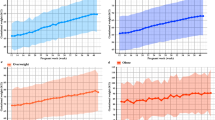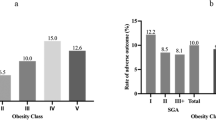Abstract
Objective:
To determine the effects of gestational diabetes mellitus (GDM) and pre-pregnancy obesity on macrosomia and large for gestational age (LGA).
Study Design:
We conducted a prospective cohort study of 587 GDM women and 478 non-GDM women from 2012 to 2013. We collected their data of the pre-pregnancy weight, sociodemographic data, medical histories, clinical treatment, and followed-up the outcomes of delivery including birth weight. Multiple logistic regression models were used to test associations between pre-pregnant obesity and macrosomia/LGA and between GDM and macrosomia/LGA.
Result:
Of 1065 women we studied, obese women had 4.17 times and 2.27 times increased risk of developing macrosomia (95% CI: 2.52 to 6.91) and LGA (95% CI: 1.60 to 3.21), respectively, than non-obese women after adjustment for maternal age, gestational weeks and GDM. We did not find GDM is a risk factor for macrosomia or LGA after GDM treatment.
Conclusion:
Pre-pregnancy obesity accounts for a high prevalence of macrosomia. Interventions that focus on pre-pregnancy obesity have the potential to reach far more women at risk of macrosomia.
This is a preview of subscription content, access via your institution
Access options
Subscribe to this journal
Receive 12 print issues and online access
$259.00 per year
only $21.58 per issue
Buy this article
- Purchase on Springer Link
- Instant access to full article PDF
Prices may be subject to local taxes which are calculated during checkout

Similar content being viewed by others
References
Schwartz R, Teramo KA . What is the significance of macrosomia? Diabetes Care 1999; 22: 1201–1205.
Lipscomb KR, Gregory K, Shaw K . The outcome of macrosomic infants weighing at least 4500 grams: Los Angeles County+University of Southern California experience. Obstet Gynecol 1995; 85: 558–564.
Li G, Kong L, Li Z, Zhang L, Fan L, Zou L et al. Prevalence of macrosomia and its risk factors in china: a multicentre survey based on birth data involving 101,723 singleton term infants. Paediatr Perinat Epidemiol 2014; 28: 345–350.
Lu Y, Zhang J, Lu X, Xi W, Li Z . Secular trends of macrosomia in southeast China, 1994-2005. BMC Public Health 2011; 11: 818.
Dodd JM, Grivell RM, Nguyen AM, Chan A, Robinson JS . Maternal and perinatal health outcomes by body mass index category. Aust N Z J Obstet Gynaecol 2011; 51: 136–140.
Metzger BE, Buchanan TA, Coustan DR, de Leiva A, Dunger DB, Hadden DR et al. Summary and recommendations of the Fifth International Workshop-Conference on Gestational Diabetes Mellitus. Diabetes Care 2007; 30 (Suppl 2): S251–S260.
Catalano PM, McIntyre HD, Cruickshank JK, McCance DR, Dyer AR, Metzger BE et al. The hyperglycemia and adverse pregnancy outcome study: associations of GDM and obesity with pregnancy outcomes. Diabetes Care 2012; 35: 780–786.
Ricart W, Lopez J, Mozas J, Pericot A, Sancho MA, Gonzalez N et al. Body mass index has a greater impact on pregnancy outcomes than gestational hyperglycaemia. Diabetologia 2005; 48: 1736–1742.
Black MH, Sacks DA, Xiang AH, Lawrence JM . The relative contribution of prepregnancy overweight and obesity, gestational weight gain, and IADPSG-defined gestational diabetes mellitus to fetal overgrowth. Diabetes Care 2013; 36: 56–62.
Liu J, Leng J, Tang C, Liu G, Hay J, Wang J et al. Maternal glucose level and body mass index measured at gestational diabetes mellitus screening and the risk of macrosomia: results from a perinatal cohort study. BMJ Open 2014; 4: e4538.
Bowers K, Laughon SK, Kiely M, Brite J, Chen Z, Zhang C . Gestational diabetes, pre-pregnancy obesity and pregnancy weight gain in relation to excess fetal growth: variations by race/ethnicity. Diabetologia 2013; 56: 1263–1271.
Langer O . Obesity or diabetes: which is more hazardous to the health of the offspring? J Matern Fetal Neonatal Med 2014; 1–24.
Kim SY, Sharma AJ, Sappenfield W, Wilson HG, Salihu HM . Association of maternal body mass index, excessive weight gain, and gestational diabetes mellitus with large-for-gestational-age births. Obstet gynecol 2014; 123: 737–744.
Vellinga A, Zawiejska A, Harreiter J, Buckley B, Di Cianni G, Lapolla A et al. Associations of body mass index (maternal BMI) and gestational diabetes mellitus with neonatal and maternal pregnancy outcomes in a Multicentre European Database (diabetes and pregnancy vitamin D and lifestyle intervention for gestational diabetes mellitus prevention). ISRN Obes 2012; 2012: 424010.
Hartling L, Dryden DM, Guthrie A, Muise M, Vandermeer B, Donovan L . Benefits and harms of treating gestational diabetes mellitus: a systematic review and meta-analysis for the U.S. Preventive Services Task Force and the National Institutes of Health Office of Medical Applications of Research. Ann Intern Med 2013; 159: 123–129.
Bener A, Saleh NM, Al-Hamaq A . Prevalence of gestational diabetes and associated maternal and neonatal complications in a fast-developing community: global comparisons. Int J Womens Health 2011; 3: 367–373.
Yangfeng W, Guansheng M, Yonghua H, Yanping L, Xian L, Zhaohui L et al. The current prevalence status of body overweight and obesity in China. Chin J Prev Med 2005; 39: 316–320.
Zhang BL . A revision report of the birth weight of male and female in different gestational age of 15 cities in China. Chin J Prac Pediatr 1992; 7: 306–307.
Yang H . Diagnosis and treatment guidelines for pregnancy associated diabetes millitus. Health Management 2014; 78–82.
Zhou B . Predictive values of body mass index and waist circumference to risk factors of related diseases in Chinese adult population. Zhonghua Liu Xing Bing Xue Za Zhi 2002; 23: 5–10.
Tomeo CA, Rich-Edwards JW, Michels KB, Berkey CS, Hunter DJ, Frazier AL et al. Reproducibility and validity of maternal recall of pregnancy-related events. Epidemiology 1999; 10: 774–777.
WHO Expert Consultation. Appropriate body-mass index for Asian populations and its implications for policy and intervention strategies. Lancet 2004; 363: 157–163.
Cedergren MI . Maternal morbid obesity and the risk of adverse pregnancy outcome. Obstet gynecol 2004; 103: 219–224.
Gu S, An X, Fang L, Zhang X, Zhang C, Wang J et al. Risk factors and long-term health consequences of macrosomia: a prospective study in Jiangsu Province, China. J Biomed Res 2012; 26: 235–240.
National Diabetes Data Group.. Classification and diagnosis of diabetes mellitus and other categories of glucose intolerance. Diabetes 1979; 28: 1039–1057.
Carpenter MW, Coustan DR . Criteria for screening tests for gestational diabetes. Am J Obstet Gynecol 1982; 144: 768–773.
Surkan PJ, Hsieh CC, Johansson AL, Dickman PW, Cnattingius S . Reasons for increasing trends in large for gestational age births. Obstet Gynecol 2004; 104: 720–726.
Orskou J, Henriksen TB, Kesmodel U, Secher NJ . Maternal characteristics and lifestyle factors and the risk of delivering high birth weight infants. Obstet Gynecol 2003; 102: 115–120.
Acknowledgements
This study was supported by a grant from the Specialized Research Fund for the Doctoral Program of Higher Education (No. 20120001110014).
Author information
Authors and Affiliations
Corresponding authors
Ethics declarations
Competing interests
The authors declare no conflict of interest.
Additional information
Supplementary Information accompanies the paper on the Journal of Perinatology website
Supplementary information
Rights and permissions
About this article
Cite this article
Wang, LF., Wang, HJ., Ao, D. et al. Influence of pre-pregnancy obesity on the development of macrosomia and large for gestational age in women with or without gestational diabetes mellitus in Chinese population. J Perinatol 35, 985–990 (2015). https://doi.org/10.1038/jp.2015.119
Received:
Revised:
Accepted:
Published:
Issue Date:
DOI: https://doi.org/10.1038/jp.2015.119
This article is cited by
-
Refining the diagnosis of gestational diabetes mellitus: a systematic review and meta-analysis
Communications Medicine (2023)
-
Association of gestational diabetes mellitus with adverse pregnancy outcomes: our experience and meta-analysis
International Journal of Diabetes in Developing Countries (2020)
-
Neonatal outcomes of singleton live births with vanishing twin syndrome following double embryos transfer in assisted reproductive technology: a retrospective cohort study
Journal of Ovarian Research (2019)
-
Similarities between acylcarnitine profiles in large for gestational age newborns and obesity
Scientific Reports (2017)



